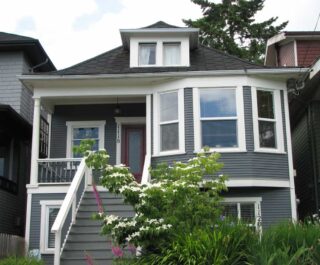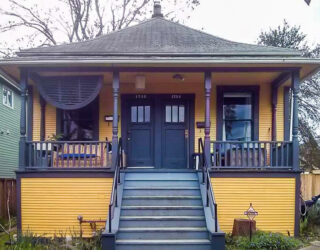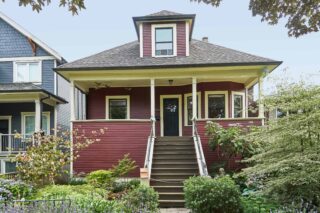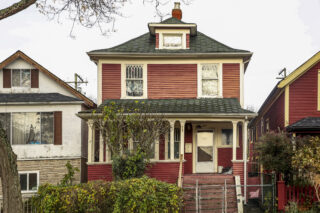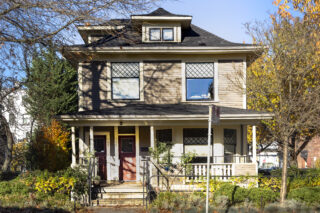Background
Colonial Revival styles emerged from the Neoclassical Revival of the late 19th century. The American Centennial of 1876 re-popularized colonial architecture from Northeast United States and these styles soon filtered down into common builder styles in Canada. These homes were built with features inspired by the classical elements of colonial styles. Based on plan-books published by architects in the United States, designs were modified to suit the builder’s ideas, the buyer’s wishes, and the different materials available. Colonial Revival homes in Vancouver have full width porches with classically inspired porch posts and dentils. They are distantly related to the more elaborate mansions such as Hycroft and The Hollies in Shaughnessy. The two-storey variant is sometimes called an Edwardian Box or Edwardian Classic.
Form
The defining element of the Colonial Revival style is the hipped roof, most of which have a single dormer centered on the front. They are also characterized by porches with Classical columns. We have included two types: Colonial Revival Cottage and 2-Storey Colonial Revival.
Colonial Revival Cottage
Form
The Colonial Revival cottage is usually a single-storey, boxy house with an integral porch, usually with the front door placed in the middle. There may be a bay window on the living-room side. Some have a bell-cast flare to the eaves. Porch posts are usually round (Tuscan) and may be grouped in twos or threes at the corners. The porch entablature is sometimes decorated with dentils, and the soffits with narrow carved brackets. Usually, the upstairs attic space, illuminated by small windows front and back in the dormers, is too small to be usable due to the low roof pitch. Cladding is typically narrow lap-siding.
Details
- Hipped roof
- Wide eaves
- One storey
- Full-width porch
- Classical columns
- Usually has single centered dormer
- Symmetrical house of square or rectangular plan
- Little ornamentation
Materials
Wood is the dominant material of the Colonial Revival cottage. They have simple siding, usually narrow clapboard but sometimes covered in stucco by later renovations. Colonial Revivals rarely have any decoration other than dentils and classical columns hold up porch roofs. Exposed soffits may be visible under the eaves.
2-Storey Colonial Revival
Form
2-storey Colonial Revivals are tall boxy buildings with a hipped roof and a central dormer, usually with an attached front porch. They are similar, except for the roof, to Gabled Vernacular Style buildings. Some larger examples have an additional half-storey illuminated by additional dormers. Porch posts and dentils are similar to the Cottage form above – that is, classically inspired.
Details
- Hipped roof
- Wide eaves
- 2 or 2 ½ storey
- Full-width porch
- Classical columns
- Doors may be centered or placed to the side
- Usually has single centered dormer
- Symmetrical house of square or rectangular plan
- Little ornamentation
Materials
Wood is the dominant material of the Colonial Revival 2-storey. They have simple siding, usually narrow clapboard but sometimes covered in stucco by later renovations. Roofs were cedar shingle, often replaced in reroofing by asphalt shingles. Windows were wood-framed and double-hung, while doors often have sidelights. Exposed soffits may be visible under the eaves. Colonial Revivals rarely have any decoration other than dentils and classically inspired columns that hold up porch roofs.

